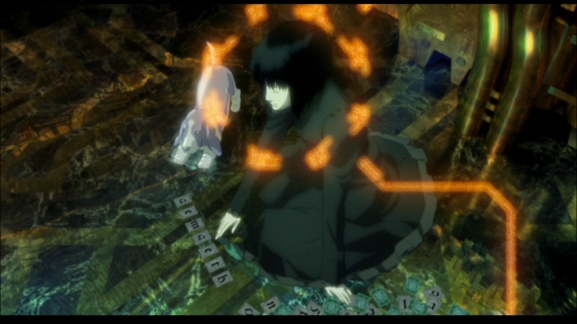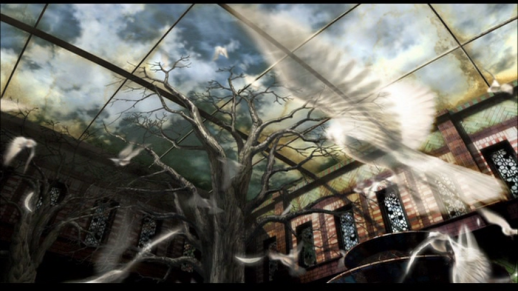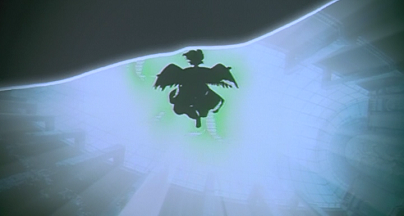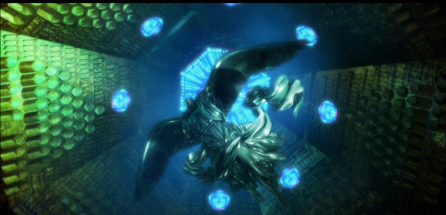Amidst the various philosophies and ideologies Oshii invokes in Innocence, the one which he seems to take some subtle opposition to is secular Transhumanism. The term having originally been coined in 1957 by Julian Huxley, the brother of Aldous Huxley (author of Brave New World (1932)), Transhumanism is a doctrine of thought that argues man’s evolutionary objective is to excel beyond his physical and psychological limitations with the use of his technology. Of course, whether or not Oshii has actually taken Transhumanism into consideration is not clear when he has never specifically mentioned his views on this subject nor has he ever remotely referenced Transhumanism. However, there are a couple of visual cues in Innocence which suggests Oshii may be quite knowledgeable about this ideology to some degree and that also indicates he is quite disenchanted with it.

The most prominent nod to Transhumanism in Innocence is the golem. In Batou’s visit to Kim’s mansion, Kusanagi tips him off to take caution in entering the mansion with the Brothers Grimm fairy tale of the golem. Aside from its appearance in fairy tales, the mythic golem has also been construed as referring to many strange and interesting motifs underlying evolutionary and transhumanist thought. Functioning almost as if it were a Promethean parable, the golem warns how man’s reach or acquirement for godhood far exceeds his grasp and could lead to adverse consequences in appropriating God’s power. In Nick Bostrom’s History of Transhumanism, Bostrom considers the movement of transhumanism as having its roots in the tale of the golem as interrelated to Kabbalistic lore. The Kabbalah was a system of Judaic thought that was a form of practice blending magic, science, and alchemy. It is also part of the Torah that describes mystical creation and how God manifests his divine powers through his own creation.
As articulated in the book on Jewish esotericism, the Sefer Yetzirah, “human-made golems could be activated by the ritualistic use of the Hebrew Alphabet, bringing the golem into life and action.” Lisa Nocks argues the golem could be an expression of the anxiety felt by man in using the “products” of his evolution in order to transition into new evolutionary states, what is seen with technological advancements made in society. Nocks further looks at the works of Moshe Idel, philosopher of Jewish mysticism, in how he “points to the gradual secularization of society for the development of the Golem’s darker side….He suggests that a certain amount of guilt and lack of confidence burdens those who strive for such knowledge without the purpose of divine communion.” Kusanagi uses the Hebrew Alphabet in order to invest Batou’s knowledge with the tale of the golem. As there is no indication in the film that Batou had any preexisting knowledge of the golem story but rather he acquired it from Kusanagi, he acts with caution in Kim’s manor based upon this hint. What Oshii thus seems to indicate is that Batou is the golem himself, for he is taking action in Kim’s manor in accordance to what Kusanagi forewarns him of through the use of the Hebrew Alphabet, the language of God. Kusanagi, who is a divinity unto herself, is seemingly using Batou as her puppet in order to carry out the investigations into Kim’s manor, and thus he becomes her own creation. When it is uncertain as to how much contact Batou and Kusanagi actually have in the film, this raises a very interesting question: who is really undertaking the investigation into the malfunctioning gynoids? Is it Kusanagi or is it Batou? If Kim’s manor is the mirror of the film itself in revealing its inner workings, then it could be Oshii is revealing Kusanagi as the one who is actually conducting the investigation and not Batou and Togusa.

Hava Tirosh-Samuelson also notes that the mystical abilities surrounding the golem as having the powers to change the human form has been adopted by some non-Jewish technoscientists in describing their own objectives with technology. Samuelson further remarks that “computer scientists who build intelligent machines that deliberately mimic human behavior invoke the golem legend to justify their endeavor on religious grounds.” With the ability to control human motions and life through a medium which is an imitation of the human image, this also implicates the ability to control human mortality with the promise of using technology to create an artificial immortality. To cheat death is generally considered by scholars on the subject as one of the primary objectives of the Transhumanist. As Batou explains to Kim and Togusa, Kusanagi’s use of the word “aemaeth” to bring the golem into life is the Hebrew word for “truth,” but when removing “ae” to form “maeth” it renders the golem back into clay and thus exposing this makeshift life as an illusion. This communicated transmutation from life to death is a key signifier to Batou warning him of peril in falling into the trap of the virtual simulations, and thence the very essence of his composition is unraveled and exposed when Batou and Togusa are fundamentally lifeless mediums that have been invested with life through the workings of animation. Batou even goes on to remark, “That prophecy told me that no truth would be found within these walls.” In other words, as related to the golem, the ability to overcome mortality through shaping and thus creating a sought after immortality through lifeless mediums, as Oshii shows with technology in how he expresses it through the medium of animation, is a false illusion, one that is alluring to its beholders due to this sensibility of immortality providing a pacifying delusion for us in negating the reality of our mortality.


Another symbol implicating an oppositional stance to Transhumanism relates to the Tree of Life. A scholar of mythology, Joseph Campbell, distinguished two mythical trees, accounting, “The principle of mythic disassociation, by which God and his world, immortality and mortality, are set apart in the Bible is expressed in a dissociation of the Tree of Knowledge from the Tree of Immortal Life. The latter has become inaccessible to man through a deliberate act of God, whereas in other mythologies, both of Europe and of the Orient, the Tree of Knowledge is itself the Tree of Immortal Life, and moreover, still accessible to man.” Campbell’s comment provides some insight into why Oshii includes the Bodhi tree in Chief Aramaki’s office to where it seems both contrasted and mirrored later on in the film with the Tree of Life seen in Kim’s domain. The Bodhi tree can be associated with the “Tree of Knowledge,” whereas the tree seen in Kim’s mansion represents the “Tree of Immortal Life” or what is described in Biblical scripture, and especially in the Quoran, as the “Tree of Life.” Furthermore, another interpretation is that “the Bodhi Tree is a tree of the visible world. It symbolizes for the Buddhist the saving knowledge that releases the being from his illusions.” As Oshii has portrayed the Tree of Life in Kim’s manor with holographic birds soaring to its peak as indicating the tree may be also mere chimera, and considering he has depicted the tree on a mural wall in Angel’s Egg and Ghost in the Shell, Oshii suggests this is a tree sought after and imagined by men but one which does not actually exist.

The reason as to why the Tree of Life in Innocence could perhaps relate to Transhumanism is because it has become a rather emblematic symbol for eugenics, which was a form of Transhumanism in the early twentieth century but one which modern Transhumanists claim they are not in support of. Eugenics is a doctrine of belief that calls for controlling the genetic quality of humans by controlling sexual reproduction in favoring more desired genetic traits over less desired genetic traits, often by means of sterilization. In her book on Eugenics, Christine Rosen examines The Tree of Life and how the “Eugenicists adopted the metaphor as their own at the Third International Eugenics Congress held in New York City in 1932. Visitors entering the exhibit hall confronted a large mural depicting an enormous tree heavy with foliage and with a banner unfurled across the top that read, simply, ‘Eugenics.’” Innocence seems to discreetly acknowledge these themes of Eugenics with Coroner Haraway’s discussion with Togusa on child rearing, her conversation on dolls and upbringing on how raising one’s progeny is like a form of genetic grooming in how the child shapes their doll in the process to understanding child rearing and obtaining “the ancient dream of artificial life.” Furthermore, Batou casually mentions to his colleagues his pet dog was the “first of his line bred by artificial insemination,” a “high-maintenance hound.”

Another interesting moment in Innocence is the scene of the burning of the dolls. In Japan, there is a temple where couples who bore children can go to and take a doll with them as their child’s surrogate to prevent anything bad to befalling their child. This eventually led to couples bringing their dolls for getting rid of them. They then arranged these pyres at the temple for burning dolls, since, “many residents are suffering over how to do away with their dolls.” What Oshii once indicated in an interview, humans today are losing their bodies, and thus they seek out different ones to affirm their existence, thence transmuting into different forms and casting away their old. For the Transhumanists, the human form is considered by them what has to be changed and surpassed in order to achieve a better life. As explained in my book, Oshii puts forth the notion in Innocence that it is requisite to have physical ties to the natural in order to have any grasp or understanding of our own existence.


Additionally, in Innocence Oshii configures the angel seen in the first film when Kusanagi merges with the Puppetmaster. He changes it from an ethereal divinity into an artificially rendered divinity in Innocence. Thus, Oshii seems to suggest with secular transhumanism is that seeking after immortality in being free from the physical limitations through extending one’s being into the technological is just as unattainable and unsatisfying as the technical spirituality organized religions promise. Oshii’s film thus seems to take an unfavorable stance towards secular Transhumanism, since Innocence visually suggests this with the golem and the Tree of Life that this movement is more of a pseudo-science, just another chimerical ideology. In interviews, both Oshii and Shirow have expressed how religion and progressive technology are very similar in their pursuits to changing humans through expanding the human form past its physical limitations, how both of these doctrines of thought seem to be converging as one. In Ghost in the Shell, Kusanagi merges with the Puppetmaster as if this was a technological singularity where human intelligence fuses with the artificial. In Innocence, considering the film suggests Oshii is self-including himself in the role of Batou, it indicates that Oshii eschews the post-human form Kusanagi obtains rather than embracing it. Thus, Oshii seems to articulate the objectives of Transhumanism is as deceptive and intangible to the limitations of our knowledge, just as much as the perfect spiritual state humans are after through their traditional theologies. This is also implicated by Batou when he remarks, “Birds seek refuge in the heavens, fish dive deep into the sea.” The birds that are seen soaring to the Tree of Life in Kim’s manor and in the skies, their forms are as transient and irreal as the human attendees witnessed at the parade. It seems to suggest there is no substance found in those who seek after the heavens. Also, towards the end of Innocence, Kusanagi states to Batou, “We weep for the blood of a bird, but not for the blood of a fish, blessed are those who have a voice.” It’s almost as if she, speaking as a divinity, an equivalent to God, is showing pity on humans in vainly aspiring for what they believe is the perfect form of their spirit.
Sources Referenced:
- http://www.japantimes.co.jp/life/2006/10/15/to-be-sorted/last-rites-for-the-memories-as-beloved-dolls-pass-away/#.V4LQYrgrKM_
- http://www.midnighteye.com/interviews/mamoru-oshii/
- Transhumanism: A Grimoire of Alchemical Agendas (2012) by Scott de Hart & Joseph P. Farrell, 39
- Preaching Eugenics: Religious Leaders and the American Eugenics Movement (2004) by Christine Rosen
- Religion and Transhumanism: The Unknown Future of Human Enhancement by Calvin Mercer & Tracy J. Trothen
- Lisa Nocks, “The Golem: Between the Technological and the Divine”
- http://users.skynet.be/lotus/tree/bodhi-en.htm
- Frederik L. Schodt, “Interview with Masamune Shirow,” JAI²,http://www.jai2.com/MSivu.htm.

I think that when we know exactly how DNA works we will change it and Homo Sapiens will be gone. And I think it’s just a couple of generation into the future.
LikeLike